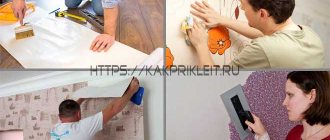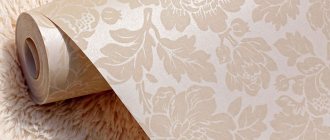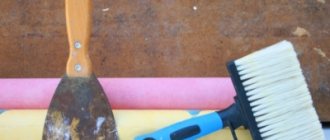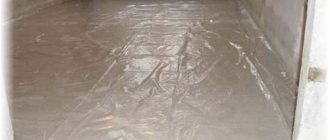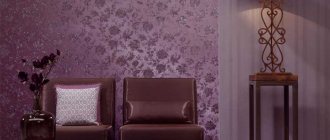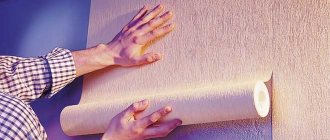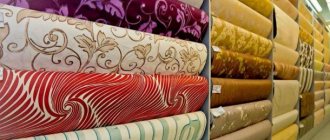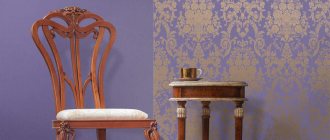When choosing wallpaper, it is necessary to take into account a variety of factors, from its combination with the interior to its physical properties. Another point that is often taken into account is the environmental friendliness of wallpaper.
Famous German wallpaper collection with geometric patterns
This is especially important when they are chosen for a child’s room. Then I would definitely like them not to be dangerous to his health. For adults, however, this is also true, and while there are usually no complaints about paper-based wallpaper in this regard, vinyl wallpaper, in the opinion of many, can cause quite serious harm. But is this true?
What are they made of?
The multilayer nature and chemical origin of the decorative surface often cause mistrust among domestic users. Questions arise due to the lack of deciphered information about the composition of raw materials. Sometimes rumors are made up by manufacturers of ordinary paper models, the demand for which begins to fall.
Non-woven building material consists of 70% cellulose. Non-woven raw materials are classified as types of paper. The prepared fibers are laid in layers and compressed under high pressure. After impregnation and processing, a durable fabric resembling fabric is obtained.
Non-woven types Source cdn.27.ua
The most expensive finishing material is wallpaper, in which all layers are made of non-woven material. The bottom layer consists of a light, smooth “lining”. The decorative top tier is often very heavy, textured and structured to the touch.
Vinyl wallpaper is produced on the basis of paper or non-woven fabric. The image is applied to the surface using embossing technology. A polyvinyl chloride mass is placed on the substrate, after which the material is processed in an oven. After melting, a beautiful decorative layer appears, giving a voluminous or silky texture.
Origin of opinion
Why do people think that vinyl wallpaper is dangerous?
The point is in their composition. They have two layers. The first is the bottom, there are wallpapers on a paper basis or, as an option, on a non-woven basis. There are usually no complaints about him. But the top one, which is made from polyvinyl chloride, worries many, as it is of purely chemical origin. Are people right who believe that such wallpaper is dangerous? Partially. It's all about the properties of this layer. It is waterproof and also steamproof.
Typical use of two types of wallpaper: plain and patterned
On the one hand, this is an extremely positive quality, which allows the coating to be very easy to clean. It can be easily washed and can be cleaned without any particular difficulty. But this property also turns out to be a disadvantage. After all, if there is no air exchange, then condensation begins to accumulate under the wallpaper.
It is this that becomes the source for the development of quite dangerous pathogenic fungi. They usually cause the main harm and cause health hazards, which even doctors warn about. An allergy may occur to these fungi, then the health consequences may be different, but definitely only negative.
Advantages and disadvantages
Safety and environmental friendliness are the main requirements for finishing materials for residential premises. The rule is relevant both for children’s bedrooms and bedrooms, as well as for rooms with extreme conditions (kitchen, bathroom). Let's look at the pros and cons of both types of raw materials.
Non-woven
High-quality material made using technology is safe for people. If the manufacturer has not reduced the cost of the composition, then the harm of non-woven wallpaper is minimal. Sometimes affordable vinyl is added instead of expensive cellulose. Real trellises do not crack when you press on the surface, but fakes have a soft, loose structure under the nail.
The finishing material made of non-woven fabric is very durable. Multi-layering ensures resistance to wear. Beautiful models do not fade under direct ultraviolet light, which allows them to be used in sunny rooms.
Rolls of material for wall decoration Source 1oboi.ru
Due to their fibrous structure, real non-woven trellises allow air to pass through. The walls in the room will “breathe”, which will protect against the appearance of fungus. Wallpaper is produced both with a finished decorative surface and in special models for painting. Enamel will not destroy the structure of the finish. After drying, the top coat is much stronger than before coating.
Non-woven trellises, like any paper, attract dust. Options with relief accumulate small particles that are not visible on a beautiful finish. If healthy people do not notice the deficiency, then residents with allergies will feel the negative aspects of the raw material. To neutralize the defect, you will have to vacuum the walls frequently.
Pros and cons Source kraski-net.ru
It is not the non-woven trellises themselves that are harmful, but the low-quality glue. It is better to take wallpaper and fixing solution from the same brand. Inexpensive models often contain ingredients that cause allergies in sensitive adults and children.
The disadvantages of non-woven finishing include limited design and colors. To make the room original, the trellises are painted. Even the safest wallpaper will become harmful after applying paint with toxic components.
Other selection criteria
If you are selecting vinyl wallpaper, then the selection criteria that will help you choose the best option may be much more than just the name of the country of origin and the inscriptions on the labels.
Modern design involves a mixture of different materials
The first important step when choosing is to personally familiarize yourself with a sample of the wallpaper that you intend to purchase. Be sure to buy the wallpaper in person, and when you do, smell it. This is a simple and even primitive method, but it is very effective.
If the wallpaper is of poor quality, if its material is harmful to humans and contains negative fumes, then such products will immediately smell sharp and extremely unpleasant.
Many people are skeptical about this method, but in fact, you can verify its objectivity using a very simple method - smell the most expensive European vinyl wallpaper that is available in the store, and then, for contrast, the cheapest. The difference will be noticeable immediately, unless, of course, you have a runny nose. If the smell is already present, then it’s easy to imagine how it will spread throughout the apartment after purchasing the wallpaper and leaving it on the walls for a long time.
One type of vinyl allows you to perfectly imitate natural finishing materials
If you have strong doubts that you can choose the wallpaper correctly and still want to take it, you can do it this way. After all, the house already contains a lot of PVC, for example, in chipboards, plastic windows and other elements.
But then try to glue such wallpaper in those rooms where you traditionally spend minimal time, or where there is good ventilation (for example, in the kitchen, where there is an exhaust hood), but it’s best not to experiment with the children’s room, only environmentally friendly ones are needed there wallpaper that is not dangerous.
Video description
Non-woven wallpaper.
Vinyl
Inexpensive finishes with luxurious designs become an affordable alternative to non-woven models. If the vinyl wallpaper is of high quality, there is no risk of harm. A layer of foamed PVC allows you to mask wall imperfections (cracks, unevenness). Rubberized top surface is resistant to:
- wet cleaning;
- directed ultraviolet;
- mechanical damage.
Vinyl trellises do not allow air to pass through well - the main disadvantage of finishing. The multilayer structure creates a dense layer on the surface through which oxygen and moisture do not penetrate. If the room is not ventilated for a day, then people in the room feel an unpleasant stuffiness.
Under the wallpaper, good conditions arise for the development of fungi and bacteria. Microorganisms are dangerous to health, so partitions must be treated with antiseptics before pasting. Models from European brands are often produced with perforations, which allow the walls to “breathe”.
Rolls of wallpaper Source skqo.com
Inexpensive trellises use low-quality components. Chinese manufacturers use compounds based on copper and zinc. The thicker the decorative layer in the finish, the more dangerous ingredients there are. After pasting the canvas, toxic substances are actively released. To determine whether vinyl wallpaper is harmful, just print a roll. The material has an unpleasant, pungent aroma of acetone or turpentine.
High-quality trellises are safe at room temperature. When heated from 170 C and above, polyvinyl chloride begins to melt. In the event of a fire, the finish does not burn, but smolders, releasing toxic fumes, like ordinary plastic. People in the room will suffer not from burns, but from poisoning by combustion products.
Advantages and disadvantages Source evrokomfort12.ru
What do manufacturers do to prevent wallpaper from harming health?
Let's give wallpaper manufacturers their due - most companies (especially European ones) try to make their products as safe as possible. The following measures are being taken:
- They make wallpaper porous, completely eliminating the problem with breathability. Mold and fungal lesions can still appear, but not more often than on paper wallpaper.
- Impregnated with antiseptic preparations to provide additional protection against mold.
- Choose less harmful materials. Conscientious companies do not add formaldehyde resins and zinc to wallpaper and avoid phenolic acid. The amount of harmful fumes is reduced.
Manufacturers also often recommend not to glue vinyl in front of windows and near heating appliances. There are warnings on the packaging and in the instructions. And whether to listen to them or not is the buyer’s decision.
How to choose the right one
Understanding whether non-woven wallpaper or vinyl trellises are harmful, you must definitely buy products from well-known manufacturers. You should not save money by purchasing cheap types on the market or secondhand. We recommend asking for a certificate of conformity in construction networks and stores.
Low quality finishes can be easily recognized by their smell. An unpleasant chemical aroma from wallpaper will warn a person about toxic ingredients in the composition of the paintings. Professionals advise checking the trellises by printing 2-3 rolls yourself. If the seal of the package is broken, the stench will evaporate after a few hours.
What to look for Source twitter.com
Manufacturers must label “breathable” vinyl wallpaper, which is minimally harmful. The label contains an indication of perforation or the presence of micropores. If you unfold the canvas, there will be small holes on the back side.
Non-woven trellises are priced 2 times more expensive than PVC analogues. You can recognize the cellulose models in the cross-section. The torn piece shows layers of fibers and thick paper. In vinyl types, the top rubberized layer divides unevenly when torn off.
The choice of material depends on the functional purpose of the room in which it is used. There will be no harm from high-quality non-woven wallpaper, which allows the decoration to be used in the nursery and bedroom. Vinyl trellises are perfect for the living room, hallway and office. In the bathroom and kitchen, we recommend tiling the walls, painting them, or using designer plaster.
What is non-woven fabric?
To figure out whether non-woven wallpaper is harmful, let’s clarify what the material is. It is based on textile and cellulose fibers containing polymer components.
Subjected to extensive processing, impregnation and combination with viscose, the raw ingredients form a durable fabric-like material. It is particularly resistant to tearing, resists exposure to a humid environment and abrasion, does not ignite, does not wrinkle and perfectly retains its original shape, and is used in industrial sectors:
- used in bindings, as a basis for advertising banners;
- Gaskets for automotive equipment are made from it;
- goods are packaged in such material;
- non-woven fabric is used as lining fabric for garment industry products;
- serves as raw material for wallpaper material.
What can be replaced
Chemical components contained in non-woven adhesive or PVC are not recommended for use in rooms for allergy sufferers. The slightest contact with an irritant can cause a negative reaction in the body. There are alternative types of wallpaper that are safe for people.
Paper
Traditional models are an affordable, environmentally friendly material that can be used in the premises of children and asthmatics. The finish has a perfectly smooth surface, so dust does not accumulate on it. Due to the ease of installation, even one person can glue the raw materials.
Fragility is the main disadvantage of paper wallpaper. Building material fades from the sun. After only 5 years, cellulose looks faded and unattractive. Tapestries cannot be washed or painted with enamel. The disadvantages are covered by the affordable cost, which allows you to regularly change the design, especially in the nursery. To buy safe models, we advise you to choose species with traditional colors (without “toxicity”).
Traditional views in the nursery Source tapeten.com.ua
Glass
The structure of the finish is more reminiscent of fabric than wallpaper. The canvas consists of glass fibers of different thicknesses. The raw materials contain natural ingredients:
- soda;
- limestone;
- quartz sand;
- clay.
The molten mass is drawn into thin threads, which are then woven on special machines to produce reliefs and patterns. Weaving perfectly allows oxygen to pass through, so even in the bathroom there will be no fungus on the wall. The material does not support combustion and does not smoke when heated.
Glass wallpaper is protected with impregnation based on modified starch. Almost all types are designed for painting with latex or water-based paint. The strong structure is resistant to mechanical damage, which is important for families with children and pets. The surface can be washed. Using abrasive products it is easy to remove marker marks from the wall.
Fiberglass trellises Source stroyportal.ru
The price of glass wallpaper is an order of magnitude higher than its vinyl and non-woven counterparts. The more complex the pattern on the surface, the more expensive the trellises. The choice of patterns and textures is limited, so they experiment only with coloring. The cost is compensated by a long service life - 30 years. During the next renovation, the finishing is difficult to dismantle.
Bamboo
Planks made of polished wood look very impressive. Visually, the design looks environmentally friendly and expensive. The material increases sound insulation, which allows you to reduce noise from restless neighbors in the bedroom or nursery. For 20 years, the natural surface does not fade.
The high price is the main disadvantage of bamboo finishing. Wallpapers are much more expensive than elite non-woven types. The material has complex cutting and facing. Trellis should not be used in rooms with high humidity.
Natural wall decoration Source izi.ua
Liquid
The finish, in structure and method of application, is more reminiscent of putty than wallpaper. Shredded cellulose (cotton, silk) fibers turn into a thick mass after adding water. The building material is applied to the walls using a special spatula. The technology is understandable even to novice painters.
During work, there is no need to adjust the patterns on the canvases or match them in corners, switches, or sockets. After drying, a perfectly smooth, dense layer (without seams) is formed on the surface. Liquid wallpaper improves the sound and heat insulation of a room, so it is suitable for children's bedrooms. The breathable properties of cellulose allow it to be used in unheated rooms.
Finishing made from cellulose fibers Source kabanchik.ua
Silk-based trellises do not fade in the sun. The finishing material does not absorb dust, so small debris will not accumulate on the surface. The walls can be vacuumed periodically to remove excess particles. If mechanical damage or children's art appears, the problem area can be easily replaced.
Pros and cons of finishing Source zen.yandex.com
The price of liquid wallpaper is higher than non-woven and vinyl analogues. It is difficult for an inexperienced painter to independently calculate the amount of finishing and choose the optimal thickness when applying. In a room with arches and ledges, a larger volume of raw materials will be needed than for smooth walls. The material takes a long time to dry - more than 3 days.
Liquid wallpaper cannot be used in damp rooms. In the bathroom, cellulose swells, losing its original characteristics. When used in the kitchen, problem areas are covered with a special protective impregnation.
Which wallpaper is the safest for health?
There are 3 types of wallpaper that are considered safe. They are presented in the table.
| Type of wallpaper | Description |
| Fiberglass | They are rightfully considered the most harmless. They are completely environmentally friendly and suitable for all rooms - even children's rooms. Performance properties are also excellent, but many buyers are put off by the high price. |
| Non-woven | “Clean” interlining without a vinyl layer is safe. The only harm is the raised texture on which dust accumulates. But the problem of possible allergies can be solved by regular washing or using a vacuum cleaner. And in children's rooms it is better to use unbleached non-woven wallpaper. |
| Paper | This wallpaper category is completely safe. But buyers are put off by the low performance properties - the paper is thin and easily deformed. |
Another harmless coating includes “liquid wallpaper”. They contain almost no artificial components and are comparable to acrylic paint.
Harm of non-woven wallpaper
Real non-woven wallpaper does not cause harm and is a high-quality finishing material, but nowadays the manufacturer, in order to reduce the cost of its product and be more competitive in the materials market, uses some tricks. Some vinyl wallpapers on a non-woven basis have been invented, which are called “non-woven”.
It is this vinyl that is dangerous to human health. As a result of combustion, it releases formaldehyde, which in turn reacts with human blood, causing irreversible consequences in the organs. Here are the organs that are negatively affected by formaldehyde: the central nervous system, skin, respiratory tract, reproductive organs, pathological changes in genetic material. Ingestion of 70 to 90 ml of formaldehyde is fatal.
The glue selected for gluing non-woven wallpaper can also be dangerous. It is important to approach the choice of glue seriously and responsibly, check the manufacturer, read the instructions, and consult with experts in this industry. After repair work, it is important to thoroughly ventilate the room before using it for domestic purposes.
Be especially careful when choosing wallpaper. Well-known manufacturers value their reputation by constantly conducting relevant research. Before purchasing wallpaper, be sure to ask the seller if there is a certificate of conformity and a sanitary-epidemiological certificate for the product. A conscientious seller will certainly satisfy your curiosity by providing such documents.
You should also pay attention to the structure of the wallpaper. Real non-woven wallpaper has a hard and dense texture, which cannot be said about a fake. Their texture is soft and easily damaged when pressed, for example with a fingernail.
And the most harmless of the negative factors of such wallpapers can be called their tendency to accumulate dust in residential and office spaces - this happens due to the textured surface of the wallpaper. This is felt especially acutely by asthmatics, people with respiratory diseases, and allergy sufferers. This problem can be solved by frequent wet cleaning of surfaces where such wallpaper is pasted.
When choosing wallpaper, look for special characteristics such as breathability (“breathable wallpaper”). The absence of this property contributes to the appearance of a fungus that is dangerous to health.
